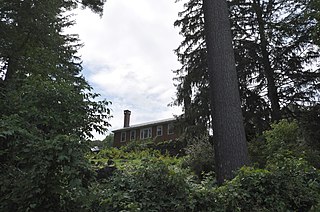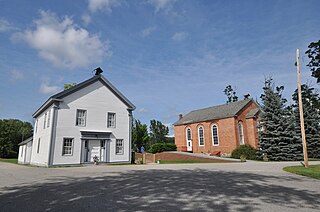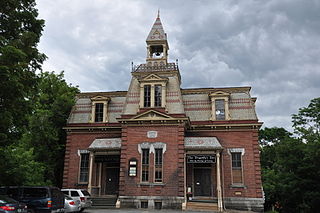
The Cushing Hotel is a historic hotel in Afton, Minnesota, United States, established in 1867 to cater to railroad workers, lumbermen, and travelers. The hotel was listed on the National Register of Historic Places in 1985 for having local significance in the theme of commerce. It was nominated for exemplifying the commercial lodging common to mid-19th-century river towns. It remains in business as the Afton House Inn.

The Merrell Tavern, known more recently as the Merrell Inn, is a historic tavern at 1565 Pleasant Street in South Lee, Massachusetts. Built in 1794 as a residence, it has served for most of two centuries as a local traveler's accommodation, and retains fine Federal period architectural details. > It was added to the National Register of Historic Places in 1972. It continues to serve its historic function, and is now operated as a bed and breakfast inn.

The Cambridge Meetinghouse, also known locally as the Old Brick Church is a historic meetinghouse at 85 Church Street in Jeffersonville, the main village of Cambridge, Vermont. Built in 1826 as a union church for several denominations, it began use as the local town hall in 1866, a use that continued to 1958. It was listed on the National Register of Historic Places in 1981. It presently houses the local post office.

Crossroads Tavern, also known as Crossroads Inn, is a historic inn and tavern located at North Garden, Albemarle County, Virginia. It was built about 1820. In the mid nineteenth century, Clifton G. Sutherland, son of Joseph Sutherland, owned and ran the tavern which was located on the Staunton and James River Turnpike. It served as a tavern and overnight lodging for farmers and travelers using the turnpike. In 1889, Daniel B. Landes bought the land at the public auction of the estate of Clifton Sutherland. The property continued to be conveyed to various owners over the years. The Crossroads Tavern is an early nineteenth century two- to three-story, three bay, double pile brick structure. The building sits on top of a brick and stone foundation, is roofed with tin and has pairs of interior brick chimneys on either gable end. The brick is laid in five course American bond with Flemish variant. Windows on the basement level at the rear of the house are barred; other basement windows are nine-over-six sash. Put-holes are found at the west end of the building, formerly providing sockets for scaffold boards should repairs be necessary. The front facade is dominated by a porch on the second story extending the entire width of the south and east facades. It is supported by five rounded brick columns and the tin roof above is supported by simple square wooden pillars connected by horizontal rails. Doors of the front of the basement level open respectively into kitchen and dining room and into a spirits cellar with its original barrel racks as well as a laundry fireplace. Floors on this level were originally dirt but dining room and kitchen floors have been cemented. The main entrance door on the second level, with its multi-panes lights, opens onto a central stair hall with two main rooms on either side. This stair hall has an ascending stair at its front and both ascending and descending stairs toward its center. Formerly the ascending stairs led to upstairs areas which did not connect. There is no ridge pole in the three attic rooms. The interiors of windows and doors on the main entrance side have extremely long wooden lintels. With few exceptions, the interior woodwork is original, including floors, chair rails, mantels and built in cupboards. Also on the property is a two-story contributing summer kitchen, brick up to the second story and frame above, and with an exterior brick chimney at the rear gable with fireplaces on both floors. It is operated as a bed and breakfast.

The Birchwood Inn is a historic tavern and inn on New Hampshire Route 45 in the center of Temple, New Hampshire. With a construction history dating to the early 19th century, it is an architecturally important example of how traveler accommodations changed in rural New Hampshire in the 19th century. The inn has been identified as "The Birchwood" since 1892, and was the town's only public accommodation for most of the 19th century. The building, still in use as a restaurant and inn, was listed on the National Register of Historic Places in 1985. In 1981 the inn and surrounding area were used in the filming of the movie Summer, based on an Edith Wharton novel.

The Londonderry Town House, or the Londonderry Town Hall is the town hall of Londonderry, Vermont. It is located on Middletown Road in the village of South Londonderry. Built in 1860, its architecture encapsulates the changing functions of this type of public venue through more than 100 years of history. It was listed on the National Register of Historic Places in 1983.

The Jenks Tavern, also known historically as the East Rupert Hotel and the Hotel G. Jenks, is a historic public accommodations house at the junction of West Dorset Road with Vermont Routes 315 and 30 in Rupert, Vermont. Built about 1807, it is a well-preserved example of an early 19th-century traveler's accommodation in southern Vermont. It was listed on the National Register of Historic Places in 1994. The building is now a private residence.

The Twing Bucknam House is a historic house on United States Route 5 south of the main village of Windsor, Vermont. Built about 1840, it is a modest brick house with a combination of features that is unique to the state and the surrounding communities. It was listed on the National Register of Historic Places in 1996.

The Fox Stand is a historic multipurpose commercial and residential building at 5615 Vermont Route 14 in Royalton, Vermont. Built in 1814, it served as a tavern and traveler accommodation on the turnpike that ran along the north bank of the White River. It has been adaptively reused in a variety of configurations, most recently as a restaurant and dwelling for the restaurant's operator. It was listed on the National Register of Historic Places in 2015 as a particularly fine example of a Federal period tavern.

The Owen Moon Farm is a historic country estate on Morgan Hill Road in South Woodstock, Vermont. Set on a steeply sloped 8-acre (3.2 ha) parcel are its main house, an 1816 brick building, a barn, and a 1930s bungaloid guest house. The hilly terrain is heavily landscaped, forming an important visual component of the estate, and serving to afford it privacy from the nearby public roads. It was listed on the National Register of Historic Places in 1983, primarily for the well-preserved Federal period architecture of the main house.

The John Strong Mansion Museum or John Strong House is a historic house museum on Vermont Route 17W in Addison, Vermont. It was built in 1795-96 by John Strong, a Vermont politician and veteran of the American Revolutionary War. It is one of Vermont's grandest examples of late 19th-century Federal architecture. It is now operated as a museum by the Daughters of the American Revolution, open between Memorial Day and Labor Day. It is surrounded by D.A.R. State Park. The house was listed on the National Register of Historic Places in 1980.

The Stagecoach Inn is a historic building at the corner of United States Route 7 and Fern Lake Road in the center of Leicester, Vermont. Built about 1830, it is one of the best-preserved examples of a 19th-century stagecoach accommodation between Rutland and Vergennes, with a distinctive combination of Federal and Greek Revival architectural elements. Now converted to a residence, it was listed on the National Register of Historic Places in 1984.

The School House and Town Hall is a historic municipal building on Schoolhouse Road, just west of United States Route 7 in the center of Leicester, Vermont. Built about 1858, it is a fine example of late Greek Revival architecture, and is the town's best-preserved district schoolhouse. Its upper floor has served as the town hall since its construction. It was listed on the National Register of Historic Places in 1988.

The David Sumner House is a historic house at 4 Station Road in Hartland, Vermont. Built about 1807, it is a fine local example of Federal period architecture, exhibiting the influence of architect Asher Benjamin. It was built for David Sumner, a major local landowner and operator of sawmills. The house, now the Sumner Mansion Inn, was listed on the National Register of Historic Places in 1989.

The Paris and Anna Fletcher House is a historic house on Vermont Route 22A in Bridport, Vermont. Built about 1813 and enlarged in the 1820s, it is a fine local example of late Federal architecture, with a distinctive shallow Doric portico. It was listed on the National Register of Historic Places in 1999, and now houses the local historical society.

The Wells River Graded School is a historic school building on United States Route 5 in the Wells River village of Newbury, Vermont. Built in 1874, it is one of the state's finest examples of Second Empire architecture. Now in commercial use, it was listed on the National Register of Historic Places in 1976.

The Montgomery House is a historic travel accommodation on Vermont Route 118 in the center of Montgomery, Vermont. Built in 1803, it is one of the town's oldest buildings, and it served for many years as a social and civic center in the small community. It was listed on the National Register of Historic Places in 1992.

The South Hero Inn is a historic commercial building at 301 United States Route 2 in the center of South Hero, Vermont. Built in 1829, it is a prominent local example of a stone building with Federal and Greek Revival features, and served as a traveler accommodation until the early 1970s. It was listed on the National Register of Historic Places in 1975. It now houses a bank.

The Darling Inn is a historic former hotel building in the center of Lyndonville, Vermont. Built in 1927–28, it is a rare example in the state of an architecturally neo-Federal building, and one of the last major constructions during the state's Colonial Revival period. Now converted to a senior care facility, it was listed on the National Register of Historic Places in 1980.

The Old Riverton Inn is a historic hotel and tavern at 436 East River Road in the Riverton village of Barkhamsted, Connecticut. Built in 1811, it has been in continuous operation as a traveler's accommodation since then. It was listed on the National Register of Historic Places in 1992.























